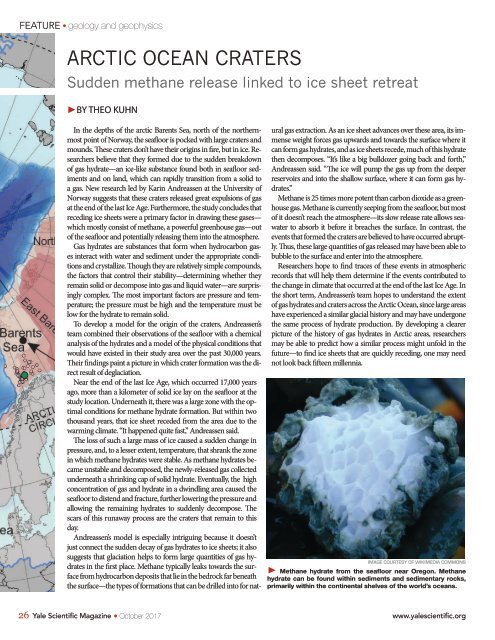YSM Issue 90.4
You also want an ePaper? Increase the reach of your titles
YUMPU automatically turns print PDFs into web optimized ePapers that Google loves.
FEATURE<br />
geology and geophysics<br />
ARCTIC OCEAN CRATERS<br />
Sudden methane release linked to ice sheet retreat<br />
►BY THEO KUHN<br />
In the depths of the arctic Barents Sea, north of the northernmost<br />
point of Norway, the seafloor is pocked with large craters and<br />
mounds. These craters don’t have their origins in fire, but in ice. Researchers<br />
believe that they formed due to the sudden breakdown<br />
of gas hydrate—an ice-like substance found both in seafloor sediments<br />
and on land, which can rapidly transition from a solid to<br />
a gas. New research led by Karin Andreassen at the University of<br />
Norway suggests that these craters released great expulsions of gas<br />
at the end of the last Ice Age. Furthermore, the study concludes that<br />
receding ice sheets were a primary factor in drawing these gases—<br />
which mostly consist of methane, a powerful greenhouse gas—out<br />
of the seafloor and potentially releasing them into the atmosphere.<br />
Gas hydrates are substances that form when hydrocarbon gases<br />
interact with water and sediment under the appropriate conditions<br />
and crystallize. Though they are relatively simple compounds,<br />
the factors that control their stability—determining whether they<br />
remain solid or decompose into gas and liquid water—are surprisingly<br />
complex. The most important factors are pressure and temperature;<br />
the pressure must be high and the temperature must be<br />
low for the hydrate to remain solid.<br />
To develop a model for the origin of the craters, Andreassen’s<br />
team combined their observations of the seafloor with a chemical<br />
analysis of the hydrates and a model of the physical conditions that<br />
would have existed in their study area over the past 30,000 years.<br />
Their findings paint a picture in which crater formation was the direct<br />
result of deglaciation.<br />
Near the end of the last Ice Age, which occurred 17,000 years<br />
ago, more than a kilometer of solid ice lay on the seafloor at the<br />
study location. Underneath it, there was a large zone with the optimal<br />
conditions for methane hydrate formation. But within two<br />
thousand years, that ice sheet receded from the area due to the<br />
warming climate. “It happened quite fast,” Andreassen said.<br />
The loss of such a large mass of ice caused a sudden change in<br />
pressure, and, to a lesser extent, temperature, that shrank the zone<br />
in which methane hydrates were stable. As methane hydrates became<br />
unstable and decomposed, the newly-released gas collected<br />
underneath a shrinking cap of solid hydrate. Eventually, the high<br />
concentration of gas and hydrate in a dwindling area caused the<br />
seafloor to distend and fracture, further lowering the pressure and<br />
allowing the remaining hydrates to suddenly decompose. The<br />
scars of this runaway process are the craters that remain to this<br />
day.<br />
Andreassen’s model is especially intriguing because it doesn’t<br />
just connect the sudden decay of gas hydrates to ice sheets; it also<br />
suggests that glaciation helps to form large quantities of gas hydrates<br />
in the first place. Methane typically leaks towards the surface<br />
from hydrocarbon deposits that lie in the bedrock far beneath<br />
the surface—the types of formations that can be drilled into for natural<br />
gas extraction. As an ice sheet advances over these area, its immense<br />
weight forces gas upwards and towards the surface where it<br />
can form gas hydrates, and as ice sheets recede, much of this hydrate<br />
then decomposes. “It’s like a big bulldozer going back and forth,”<br />
Andreassen said. “The ice will pump the gas up from the deeper<br />
reservoirs and into the shallow surface, where it can form gas hydrates.”<br />
Methane is 25 times more potent than carbon dioxide as a greenhouse<br />
gas. Methane is currently seeping from the seafloor, but most<br />
of it doesn’t reach the atmosphere—its slow release rate allows seawater<br />
to absorb it before it breaches the surface. In contrast, the<br />
events that formed the craters are believed to have occurred abruptly.<br />
Thus, these large quantities of gas released may have been able to<br />
bubble to the surface and enter into the atmosphere.<br />
Researchers hope to find traces of these events in atmospheric<br />
records that will help them determine if the events contributed to<br />
the change in climate that occurred at the end of the last Ice Age. In<br />
the short term, Andreassen’s team hopes to understand the extent<br />
of gas hydrates and craters across the Arctic Ocean, since large areas<br />
have experienced a similar glacial history and may have undergone<br />
the same process of hydrate production. By developing a clearer<br />
picture of the history of gas hydrates in Arctic areas, researchers<br />
may be able to predict how a similar process might unfold in the<br />
future—to find ice sheets that are quickly receding, one may need<br />
not look back fifteen millennia.<br />
IMAGE COURTESY OF WIKIMEDIA COMMONS<br />
► Methane hydrate from the seafloor near Oregon. Methane<br />
hydrate can be found within sediments and sedimentary rocks,<br />
primarily within the continental shelves of the world’s oceans.<br />
26 Yale Scientific Magazine October 2017 www.yalescientific.org


















